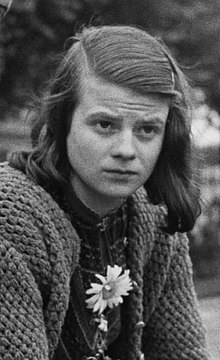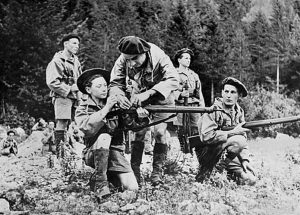(Transgender?) History Lesson
Today’s History Lesson:
When the W junta was in power, I started reading books about the French, Italian, Polish, and Russian Resistance movements, especially books by veterans of said movements. Powerful stuff.
These men, women, and children knew that, if caught, they would be tortured and butchered, and their families (even whole villages) may have shared their fate. But they fought the fascists anyway- because it was the right thing to do.
I think of Sophie Scholl, a 22 year old German University student who was beheaded by the Gestapo for the crime of believing Right Wing Fascism was wrong, and trying to persuade others of this by using leaflets.
So- obviously the Resistance movements in the occupied territories began when the territories were conquered by the Nazis. A lot of the manpower of the Resistance movements came from soldiers who escaped when their armies surrendered (or who were paroled after surrender.)
That was especially the case with the French Resistance: the Maquis. France fell incredibly quickly, 46 days, despite having a huge numerical advantage over the Germans as well as the best tank of the time- the Char B1. Due to a combination of the German armies not of sleeping for days (they were on an early form of methamphetamines,) poor French defensive planning, and General Guderian’s partially improvised plan for Blitzkreig, the French forces were swiftly pushed back.
However, another factor was in play. The French generals despised the “liberal” government, and agreed with a lot of Hitler’s ideas. They were eager for a more “conservative” and anti-Semitic government, and were quick to surrender.
However, many of their soldiers were not ready to capitulate. Many of them took to the forests and hills, and the Maquis was born. The same happened in other conquered countries.
Maquis cells operated independently. They had to — as if one was compromised, then the others could keep operating. The Gestapo sent French agents to infiltrate the Resistance, but after a while, the freedom fighters became adept at spotting them, and eliminating them. These collaborators were Frenchmen who joined the Gestapo or the even the German army after France fell.
There were resistance factions of many different political stripes. One of the largest was the “Red Orchestra,” a communist group supported by the Soviets, which operated in multiple countries including Germany. Some groups were loyal to Charles De Gaulle. Others followed Jean Moulin, Jean-Pierre Lévy and Emmanuel d’Astier. Socialists followed Pierre Brossolette and Daniel Mayer. Most groups and fighters were willing to put aside political differences in the face of their common enemy, but, occasionally inter-faction fights would boil over.
As D-Day approached, the Allies began to unite the various cells. Jean Moulin was tasked by De Gaulle to form an umbrella Maquis: Conseil National de la Resistance. Allies communicated with the Maquis by using Radio Londres, operated by the BBC, to send coded messages to various cells.
I also think about the lucky few who survived the war- and what they did to those who collaborated with the Fascists — especially the women. There was some debate about whether these women deserved what happened after the war as punishment for selling out their Nations to Fascism. When the war was over and the Germans were expelled from France, the Nazi collaborators were the first to be prosecuted and punished for their crimes against the French nation. A wave of pursuits of traitors occurred, followed by executions of those tied to the Nazi regime. There were three periods in the search for collaborators. First, the “wild phase,” which included convictions, public executions, and humiliation of the suspected traitors. The second, “Legal purge,” began on June 26, 1944, when Charles de Gaulle, now head of the Provisional Government of the French Republic, started a campaign of legal pursuits of the collaborators. (Simonovski)
Approximately 120,000 people sentenced to various punishments. The third phase was the most lenient toward the suspected Nazi assistants, and it included the trials of Philippe Pétain, who was charged with treason in 1945, and the French novelist Louis-Ferdinand Céline, who supported the Axis forces and wrote anti-Semitic pamphlets during the war. (Simonovski)
An estimated 6,000 executions were carried out by the Maquis before France was liberated, and another 4,000 occurred after the country was freed. The pursuits were carried out by both individuals and organizations. Many women who were suspected of having romantic relations with German soldiers, or were prostitutes that provided their services to the enemy, were punished and humiliated by having their heads shaved publicly. People who profited during the war were executed as well. The French members of the Waffen-SS who managed to survive the war were also treated as traitors. The higher-ranking officers were executed, and the lesser officers were sent to prison or given the opportunity to join the Foreign Legion. (Simonovski)
The loyal French who’d fought and bled to free their county from Fascism never forgave or forgot those who collaborated with the Fascists, nor should they have.
So why am I writing about this? Because history is important… and it repeats.
Sources:
Blitzed: Drugs in Nazi Germany by Norman Ohler, Shaun Whiteside (Translator)
Code Name Christiane Clouet: A Woman in the French Resistance by Claire, Jane K. Stott (Translator), Jane Kielty Stott
Fighters in the Shadows: A New History of the French Resistance by Robert Gildea
In the Shadows of War: An American Pilot’s Odyssey Through Occupied France and the Camps of Nazi Germany by Thomas Childers
A Noble Treason: The Story of Sophie Scholl and the White Rose Revolt Against Hitler by Richard Hanser
The Resistance (Time/Life Books) by Russell Miller
Soldiers Of The Night: The Story Of The French Resistance by David Schoenbrun
Sophie Scholl and the White Rose by Annette Dumbach, Jud Newborn
War in the Shadow of Auschwitz: Memoirs of a Polish Resistance Fighter and Survivor of the Death Camps by John Wiernicki
Spymistress: The True Story of the Greatest Female Secret Agent of World War II by William Stevenson
Red Orchestra: The Story of the Berlin Underground and the Circle of Friends Who Resisted Hitler by Anne Nelson
France during World War II: From Defeat to Liberation by Thomas R. Christofferson and Michael S. Christofferson
Nikola Simonovski https://www.thevintagenews.com/2017/06/02/how-france-dealt-with-those-who-collaborated-with-the-nazis-after-wars-end/ Retrieved October 23, 2018
Moved to make a comment? Login here and use the comment area below.
Category: History, Transgender Opinion, Transgender Politics












